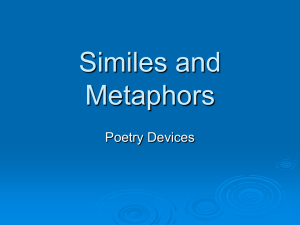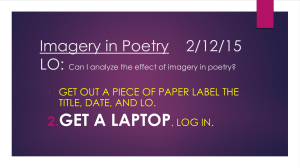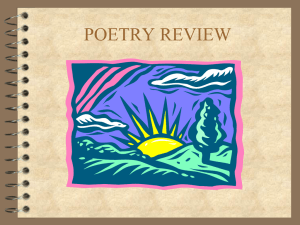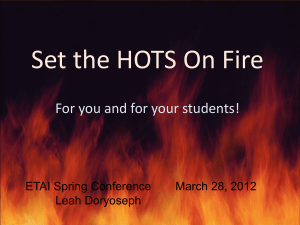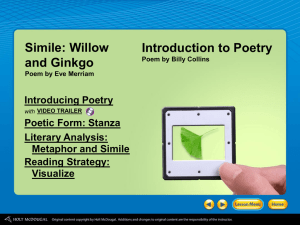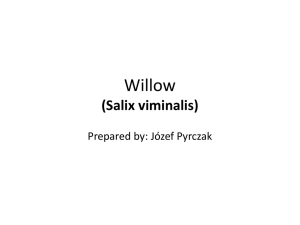Poetry Terms
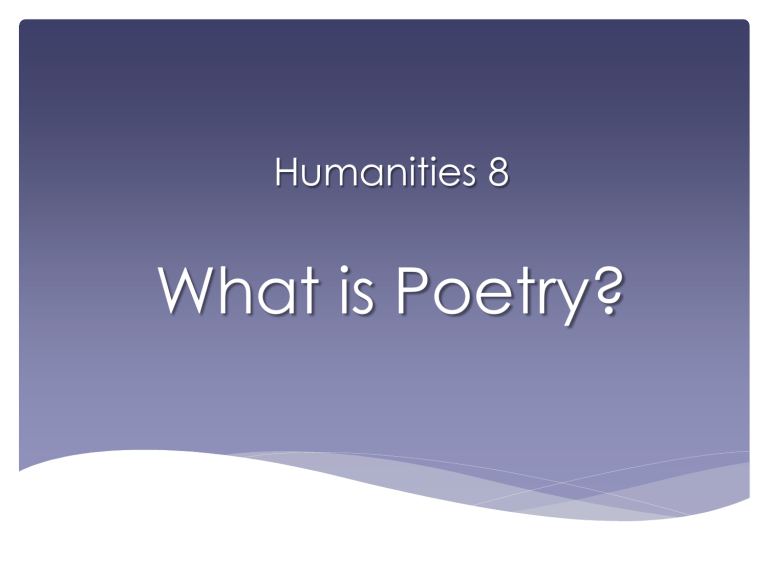
Humanities 8
What is Poetry?
Lesson #1
Introduction to What is Poetry?
What do you think poetry is?
Why do people write poetry?
What is the difference between poetry and other written texts?
Hand out Video Response Sheet and review questions as a class.
Lesson #1
What is Poetry?
Video interview with Michael Rosen
Lesson #1
What is Poetry?
Let’s review – What is poetry?
Lesson #1
Chocolate Cake
by Michael Rosen
Lesson #1
What is Poetry?
Poetry is expressive words and phrases to describe feelings, thoughts, emotions, experiences, places and objects.
Poetry can be humorous or tragic, philosophical or silly.
Lesson #1
Poetry Terms
Line
A single line of words in a poem.
Example:
“ The willow is like an etching, ”
Stanza
A grouping of two or more lines of poetry; stanzas in a poem can have different numbers of lines.
Example:
“ The willow is like an etching,
Fine-lined against the sky.
The gingko is like a crude sketch,
Hardly worthy to be signed.
”
Rhyme
A repetition of sounds at the end of words.
Example: pool rhymes with rule bake rhymes with make
Simile
A stated comparison of two things that have some quality in common using the words like or as
Example:
“ The willow is like an etching ”
Metaphor
A stated comparison of two things that have some quality in common
NOT using the words like or as.
Example:
My hands were ice cold after shoveling snow.
Lesson #1
Poem Exercise
“Simile: Willow and Ginkgo” poem
Willow Ginkgo
Lesson #1
Putting it all together
“Simile: Willow and Ginkgo” poem
Number the lines
Draw boxes around stanzas
Circle rhyming words
Underline metaphors once
Underline similes twice
Lesson #1
“Willow and Gingko”-Stanza 1
(I Do)
• How many lines does stanza one have?
• What are some examples of rhyming words?
• What is an example of a simile?
• Remember, there are no metaphors in this poem. However, an example that would fit into stanza one is: Its leaves are silk
Lesson #1
“Willow and Gingko”-Stanza 2
(We Do)
How many lines does stanza two have?
How many stanzas does the entire poem have?
What are some examples of rhyming words in stanza two?
What is an example of a simile in stanza two?
Remember, there are no metaphors in this poem.
Create a metaphor that you think would fit into stanza two. Think about what you can compare the willow or ginko to WITHOUT using the words “like” or
“as”.
Lesson #1
Let’s Review
• Rhyme: words that have the same ending sound (ex: far and car)
• Line: a single line of poetry
• Stanza: a group of lines; a paragraph
• Metaphor: a comparison that does not use the words like or as Examples: ice cold, puke green
• Simile: a comparison that does use the terms like and as
Examples: as tall as a giant, smooth like ice
Lesson #1
Simile and Metaphor
Practice
Please complete the ‘Using
Similes and Metaphors in Our
Own Poetry’ worksheet and keep it in your LA binder for future reference.
Lesson # 2
Poetry Devices
Lesson #2
Alliteration
The repetition of the same consonant sound at the beginning of two or more words
Example:
W aves w ant to be w heels
Lesson #2
Onomatopoeia
The use of words that sound like the natural noises they name
Examples:
Crack, Snap, Pop
Lesson #2
Personification
Giving human characteristics to something non-human
Examples:
My homework grew legs and walked away
My dog told me I shouldn’t do my homework.
The frost paints the pines in the winter time.
Lesson #2
Hyperbole
A ridiculous exaggeration that can by funny and makes a point.
Examples are:
“I had to walk 15 miles to school in the snow, uphill”
“You could have knocked me over with a feather”.
Lesson #2
Imagery
Words and phrases that appeal to the five senses (sight, sound, smell, touch, and taste)
Examples:
Sight - The sunset glowed in the distance
Sound - The thunder boomed loudly
Smell - The smell of apple pie filled the apartment
Touch - The bed was as soft as a cloud
Taste - The dinner tasted like I imagine garbage tastes
Lesson #2
Writing Practice
Follow the instructions on the hand-out sheets,
My Alliteration and Onomatopoeia Poems and
Personification Practice
Hand both into me when done!
USE YOUR OWN WORDS!!
Lesson #2
Let’s Review
Alliterations - the repetition of the same consonant sound at the beginning of two or more words.
Onomatopoeia - the use of words that sound like the natural noises they name.
Personification - giving human characteristics to something non-human
Hyperbole A ridiculous exaggeration that can by funny and makes a point.
Imagery - words and phrases that appeal to the five senses
(sight, sound, smell, touch, and taste)

